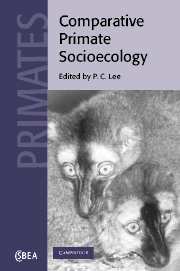Book contents
- Frontmatter
- Contents
- List of contributors
- Preface
- Part 1 Comparative methods
- 1 The comparative method: principles and illustrations from primate socioecology
- 2 Cladistics as a tool in comparative analysis
- 3 Phylogenetically independent comparisons and primate phylogeny
- Part 2 Comparative life history and biology
- Part 3 Comparative socioecology and social evolution
- Editor's conclusion: Socioecology and social evolution
- Index
2 - Cladistics as a tool in comparative analysis
Published online by Cambridge University Press: 24 August 2009
- Frontmatter
- Contents
- List of contributors
- Preface
- Part 1 Comparative methods
- 1 The comparative method: principles and illustrations from primate socioecology
- 2 Cladistics as a tool in comparative analysis
- 3 Phylogenetically independent comparisons and primate phylogeny
- Part 2 Comparative life history and biology
- Part 3 Comparative socioecology and social evolution
- Editor's conclusion: Socioecology and social evolution
- Index
Summary
Introduction
In recent years, our understanding of primate evolutionary biology and adaptive strategies has benefited greatly from advances in comparative biology (see, for example, Clutton-Brock and Harvey, 1984; Ridley, 1986; Dunbar, 1992). Nevertheless, it is now widely recognised that because closely related species may share many features inherited from a common ancestor, as statistical units these species are not independent (Ridley, 1983; Harvey and Pagel, 1991).
To take account of this problem, a range of methods has been developed that places evolutionary history, in the form of phylogeny, at the heart of comparative analysis. These methods differ in their application of evolutionary assumptions and statistical procedure. Cladistic methods involve the generation of bifurcating trees that describe the relationships between species or other taxa. These trees may then be used as a framework for the comparative analysis of other, independent features of those species. Most procedures for generating trees require data that are discrete, rather than continuous, and many cladistic debates ultimately focus on the details of these character definitions. Cladistic methods that involve parsimony or compatibility criteria proceed by tracing historical relationships among taxa based upon patterns of shared, derived characters. In the same way, mapping other characters onto the tree framework permits the assessment of whether these characters are shared and derived, revealing the evolutionary history of those characters.
This approach may be adopted as a basis for testing adaptational hypotheses within a comparative framework, or for assessing the temporal sequence of changes in descriptive characters.
- Type
- Chapter
- Information
- Comparative Primate Socioecology , pp. 23 - 43Publisher: Cambridge University PressPrint publication year: 1999
- 3
- Cited by



